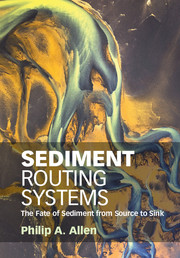Book contents
- Frontmatter
- Contents
- Preface
- Part I A Global View of Sediment Routing Systems
- Part II The Segments of Sediment Routing Systems
- 4 The Catchment-Fluvial Segment
- 5 The Continental Shelf Segment
- 6 The Deep Marine Segment
- Part III The Functioning of Sediment Routing Systems
- Part IV The Stratigraphic Record of Sediment Routing Systems
- References
- Index
5 - The Continental Shelf Segment
from Part II - The Segments of Sediment Routing Systems
Published online by Cambridge University Press: 03 October 2017
- Frontmatter
- Contents
- Preface
- Part I A Global View of Sediment Routing Systems
- Part II The Segments of Sediment Routing Systems
- 4 The Catchment-Fluvial Segment
- 5 The Continental Shelf Segment
- 6 The Deep Marine Segment
- Part III The Functioning of Sediment Routing Systems
- Part IV The Stratigraphic Record of Sediment Routing Systems
- References
- Index
Summary
Dynamics at River Mouths
The sediment routing system is strongly impacted by deposition at the coast in subaerial and subqueous deltas. The coast is the most dynamic of transition zones and moving boundaries in sediment routing systems. Deltas comprise the inclined and commonly sigmoidal sediment bodies, or clinoforms, that are the building blocks for much of the stratigraphic record of continental margins. The inclined depositional surfaces migrate by progradation driven by sediment supply. Deposition in deltas is strongly influenced by the sediment discharge of rivers as well as the physical oceanography and bathymetry of the marine basin into which the river debouches (Wright, 1977; Allen, 1997). The clinoforms in the stratigraphic record, caused by the migration of the front of deltas, are commonly recognised on seismic reflection profiles. The shape of the clinoforms reflects the interplay of river discharge and basin energy (Swenson et al., 2005).
The processes at river mouths fall broadly into the phenomena known as mixing.Mixing is encountered in a variety of natural environmental settings, such as the meeting of two rivers with different sediment loads at a confluence, the flow into a lake of a meltwater stream, the mixing of fresh and salty water in an estuary, and the eruption into the atmosphere of a column of ash from a volcano. The primary concern here is the dynamics of rivers entering the ocean, which can be divided into two broad categories:
1. Buoyancy-driven flow resulting from density differences between fresh and salty water, which gives rise to a low-salinity plume moving over a lower salty layer, and
2. Inertia-driven flow of river water into a reservoir such as a lake or sea, known as a jet.
Instabilities commonly develop at the interface between different fluids as a result of interfacial shear. These instabilities may grow into vortices that draw in ambient fluid, causing mixing of the two fluid masses. Alternatively, instabilities may be damped by the density contrast of two fluid masses. Consequently, mixing is fundamentally important to sediment deposition since mixing leads to a reduction of the density differences that drive fluid motion and keep sediment grains suspended, mixing leads to flow expansion by the entrainment of one fluid mass into the other, causing deceleration, and mixing may also cause geochemical changes leading to precipitation and flocculation.
- Type
- Chapter
- Information
- Sediment Routing SystemsThe Fate of Sediment from Source to Sink, pp. 131 - 169Publisher: Cambridge University PressPrint publication year: 2017



